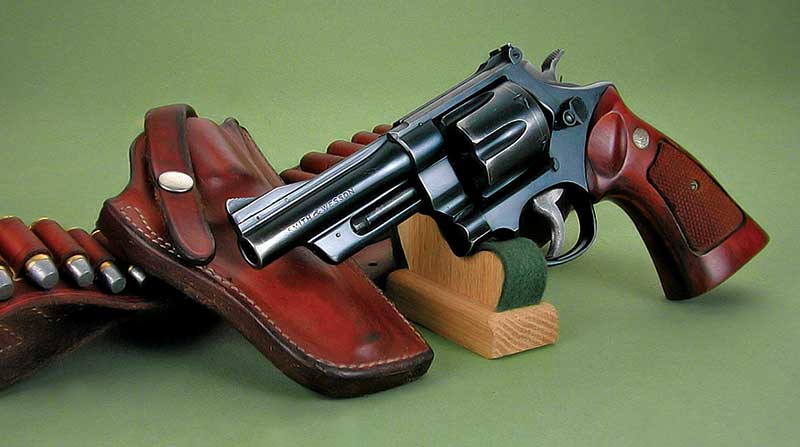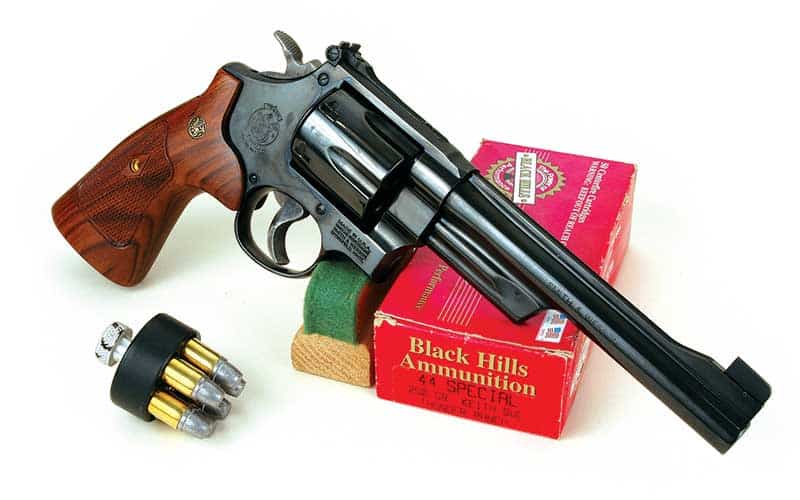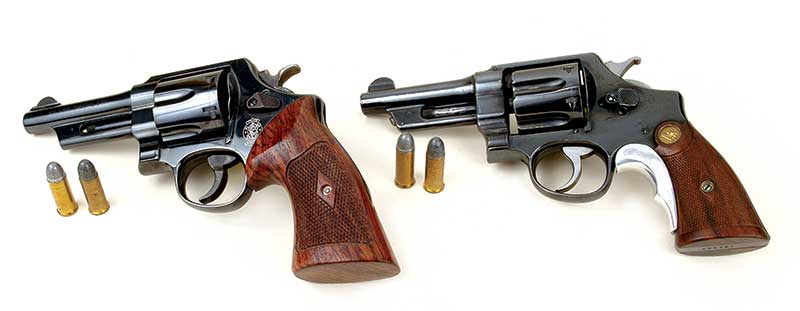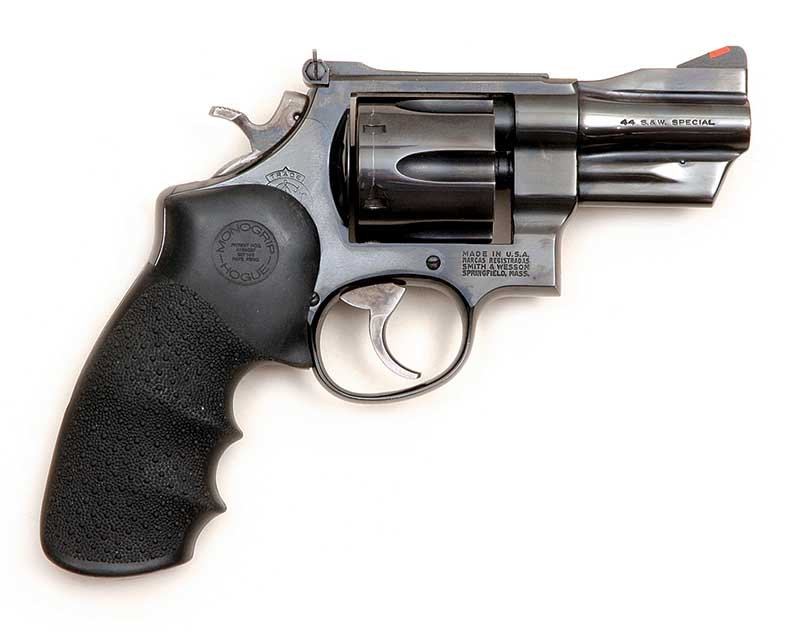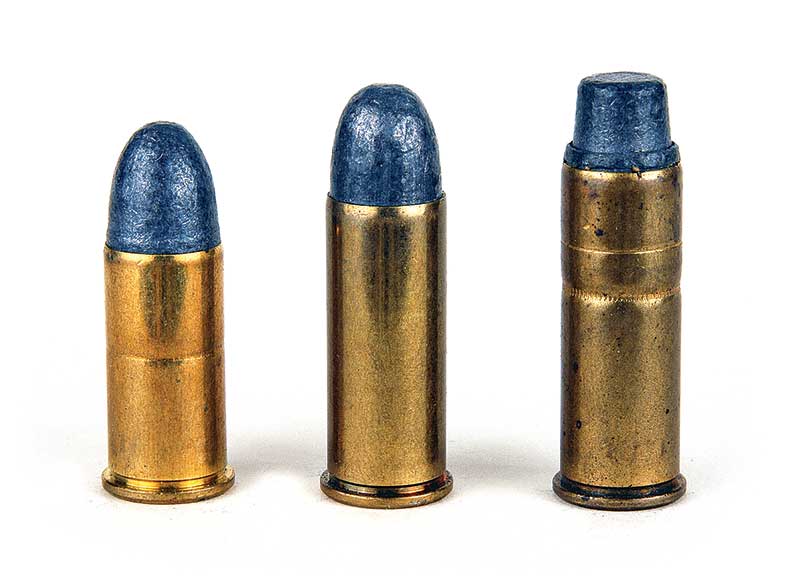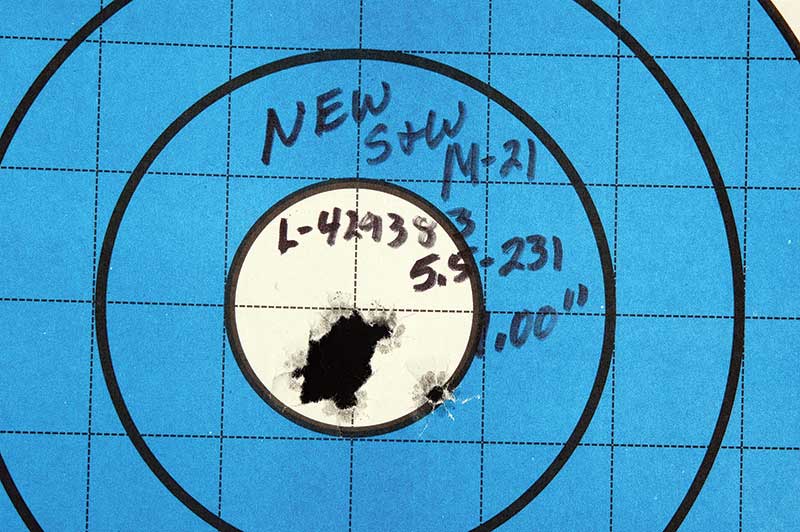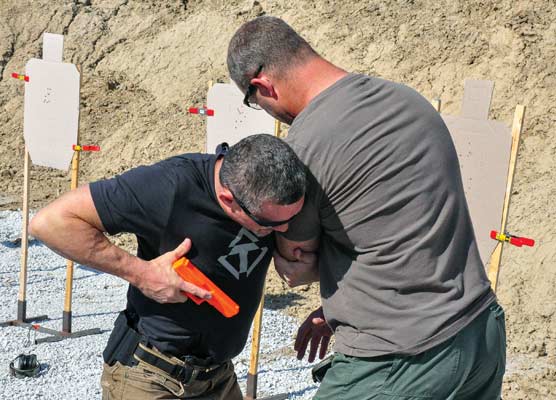The .44 Special
Ain't So Special?
Is This Heresy? Will Duke Get Away With This?
The .44 S&W Special ain’t so special. That may be heresy to some, most notably some gun’riters who almost genuflect at the name. But it just ain’t so great. In regards to the criterion by which revolvers and their cartridges are judged, the .44 Special can’t do a single thing many others do just as well — or better. Or better?
Not only will I say the .44 Special ain’t so special I will even say it was never needed. Because — for most of their concurrent production periods the .44 S&W Russian was loaded to the same ballistics as the longer .44 Special. That was with identical 246 grain, lead, roundnose .429″ diameter bullets at 755 fps. The only difference between the .44 Special and the .44 Russian is that the former’s case length is 1.16″ and the latter’s is .9″.
So why did the .44 Special develop such a strong mystique? Because of gun’riters like Elmer Keith and Skeeter Skelton. Elmer used that extra case capacity so he could load it HOT; as in hot enough to lift the topstrap off of some test revolvers. Skeeter liked to load it much milder; as in about 900 fps with 250 grain bullets. His reason for favoring the .44 Special so much was he considered it inherently accurate. But crusty old Charlie Askins had an individualistic streak in him. He wrote the .44 Special was never needed because there was already the .44-40. Atta-boy Charlie!
Revolver accuracy is a combination of factors like barrel quality, forcing cone smoothness, cylinder chamber mouths matching barrel diameter and other tidbits. Those are all factors in the handguns themselves. Then with the cartridge there are things like proper size bullets of proper temper of alloy for the pressure level desired, bullet lubricant, powder of proper burning rate for the pressure level desired, a concentric crimp applied evenly around the case mouth and much more. The most finely crafted revolver cannot shoot accurately with poorly constructed ammunition, and perfectly made ammunition cannot deliver precision from an improperly manufactured revolver. The idea of “inherent accuracy” from a revolver cartridge is a myth.
The Myth
The reason for that myth’s existence is just that sometimes the handgun maker’s engineers and the ammunition maker’s engineers happen to spec things out so they mate well. That has occurred much more often with revolvers and ammunition for the .38 Special, .357 Magnum, .41 Magnum and .44 Magnum than it has for the .44 Special, .45 ACP/.45 Auto-Rim or .45 Colt.
I have a S&W Military & Police .38 Special dating from the late 1940s. From a machine rest with .38 Special 148 grain full wadcutter factory loads, that worn-looking old gun will group five shots in about an inch at 25 yards. It is superbly accurate. Its barrel is .357″ and its chamber mouths uniformly measure .358″.
Conversely, the only handgun I sold because it was dismally inaccurate was a handsome, nickel-plated Colt SAA .44 Special with 4¾” barrel. That thing wouldn’t keep five shots of any factory load or handload inside 4″ at 25 yards, likewise fired from machine rest. I discovered the probable cause for its bullet-spraying tendency, though. Being of fairly early 3rd Generation manufacture, for some reason Colt saw fit to drill its cylinder with .435″ chamber mouths. Firing bullets of .429/.430″ through .435″ chamber mouths and into .427″ barrels (Colt’s diameter for all .44 caliber barrels) is a sure recipe for poor groups.

These four loads show various ways the .44 Special is loaded. Left to right: Winchester “Cowboy”
load with 240 grain RN/FP bullet; Winchester’s standard load with 246 RN bullet; Black Hill’s load
with 250 grain SWC bullet; and one of Duke’s handloads using Redding/SAECO 248 grain RN cast bullet (#442).
Me? .44 Special?
Now, before some of you guys start sharpening your hatchets let me fess-up that for years — even decades — I bought into the .44 Special myth. I just perused my hand-jotted records of all the handguns I’ve owned starting in 1966 and there were 21 .44 Specials listed. They run the gamut from those little Charter Arms five-shooters to all the legendary S&W N-frame double actions, through several Colt SAAs and on to one of the latest — the Smith & Wesson/Clint Smith collaboration. That one was called the Model 21-4 Thunder Ranch Revolver. At this writing I still have six; none of which have been kept because they are “special” in regards to shooting, but because they are special in regards to collecting or for sentimental reasons.
Back in January 1980 I was so enthused upon learning of a S&W Model 1950 Target .44 Special with rare 4″ barrel for sale I drove nearly 400 miles round trip on extremely icy roads to grab it before someone else did. It wasn’t that special. In fact it was the first of four Model 1950 Target .44 Specials (Model 24s) and one stainless Model 624 I have owned, and none shot that great. Right now I have one of S&W’s brand new Model 24s on loan and it doesn’t shoot that great either. Sorry boys.
Saying a revolver doesn’t “shoot great” isn’t the same thing as saying those .44 Specials shot terrible. They all grouped fair to middling, say 2.5″ to 3″ five-shot, 25 yard groups, or occasionally a 10- or 12-shot group of about the same size. It’s just that such groups are nowhere near grounds for a “special” accuracy reputation. In my career I’ve tested many far more accurate handguns, and I’m talking ordinary off the shelf types, not custom jobs.
For instance, I once developed handloads for two S&W Model 29 .44 Magnums with 6½” barrels that averaged around 1.5″ for 5-shot groups at 50 yards. In fact my favorite pair of Colt 1873/1973 PEACEMAKER CENTENNIAL .44-40s and our three U.S. Firearms .44-40s will all shoot tighter groups than any .44 Special I’ve encountered.
But Wait ...
There’s more, as they say. Lacking special accuracy potential isn’t the only reason I don’t consider the .44 Special to be special. From the ammunition factories it’s never been loaded to any sort of “special” ballistics either. As said early on, for most of its 100-year production life the .44 S&W Special was loaded with 246 grain roundnose lead bullets at around 755 fps. Then starting in the 1980s the big three — Federal, Remington and Winchester — began to modernize factory loads. They put out various types of hollowpoint and/or semiwadcutter bullets of only 200 grains traveling at speeds of about 900 fps. The keyword in this paragraph is “about” because in actual fact few of those factory loads reached their advertised specs. Usually the traditional 246 grain factory loads were lucky to hit 700 fps and the later 200 grain types often didn’t break 800 fps.
As regards to self defense revolvers, why would anyone pick a .44 Special with its un-special factory loads, when revolvers chambered for .41 Magnum, .44 Magnum, .45 ACP/.45 Auto-Rim and .45 Colt offered better options? It should be noted that coinciding with those new Thunder Ranch/Model 21 .44 Special revolvers, both Black Hills Ammunition and Cor-Bon have brought out some top-notch factory loads. They were almost a century late, though!
Handloaders have always been able to improve on .44 Special factory load ballistics, but often haven’t been very smart about it. I was one of them once. As soon as I found a fine S&W target-sighted triplelock I had to load up Elmer Keith’s recommended heavy handload to try. I won’t mention its details here and you will see why in the next sentence. At the first shot the triplelock’s cylinder fell open. Perplexed, and not very intelligently, I fired another round. The cylinder fell open again and that ended my use of such hot .44 Special handloads forever. The old six-shooter wasn’t damaged — luckily.
Today’s .44 Special handloaders can go to the latest Speer Reloading Manual #14 and find any number of suggested loads with 250 grain bullets that go upwards of 850 to 1,000 fps. And of course milder ones too, for duplicating original ballistics and general fun shooting.
The Last Straw
And here’s one last fact about the .44 Special’s lack of special-ness — that was in sales. Revolvers chambered for that caliber have never set sales records. From 1908 upon introduction by S&W, until 1966 when they dropped it completely for the first time, they sold less than 50,000 .44 Special revolvers. Those included such famous versions as the triplelock (1st Model .44 Hand Ejector), 2nd Model, .44 Hand Ejector, 3rd .44 Model Hand Ejector (Model 1926) and 4th Model Hand Ejector (Model 1950 Target, Model 24 and the Model 1950 Military, the Model 21. Let’s just look at details of just the last two models. Between 1950 and 1966 only 5,050 of the Model 1950 Target .44 Special were made and exactly 1,200 of the fixed sight Model 1950 Military were made.
Colt Single Action Army revolvers were even more sparse as .44 Specials. Colt only made 506 chambered for .44 Special between the cartridge’s introduction and the SAA’s first demise in 1941. Colt’s other revolver that was chambered for .44 Special was the DA New Service. I have no idea how many of those were made as .44 Specials but I can say I’ve seen more as .44-40s. Many more Colt SAAs were made in 2nd and 3rd Generations from 1956 to present as .44 Specials, but due to my earlier experiences with them I will buy no more. In that type of handgun give me a .44-40 any day. For DA revolvers make mine a .45 Auto-Rim such as the new S&W Model 22 also Thunder Ranch Revolver. Among non-magnum, big bore, handgun cartridges that one shines.
The .44 S&W Special isn’t a bad cartridge, and with a few exceptions the handguns made for it haven’t been bad revolvers. It’s just that neither cartridge nor handguns deserve any kind of “special” reputation. Among big bore handgun cartridges and their revolvers they’re just a sort of mediocre, middle of the pack, combination. Heresy? Nope, just the truth.
Subscribe To American Handgunner

Get More Revolver Content Every Week!
Sign up for the Wheelgun Wednesday newsletter here:


